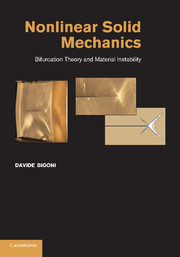Book contents
- Frontmatter
- Contents
- Preface
- Foreword by Giulio Maier
- 1 Introduction
- 2 Elements of tensor algebra and analysis
- 3 Solid mechanics at finite strains
- 4 Isotropic non-linear hyperelasticity
- 5 Solutions of simple problems in finitely deformed non-linear elastic solids
- 6 Constitutive equations and anisotropic elasticity
- 7 Yield functions with emphasis on pressure sensitivity
- 8 Elastoplastic constitutive equations
- 9 Moving discontinuities and boundary value problems
- 10 Global conditions of uniqueness and stability
- 11 Local conditions for uniqueness and stability
- 12 Incremental bifurcation of elastic solids
- 13 Applications of local and global uniqueness and stability criteria to non-associative elastoplasticity
- 14 Wave propagation, stability and bifurcation
- 15 Post-critical behaviour and multiple shear band formation
- 16 A perturbative approach to material instability
- References
- Index
- Plate section
13 - Applications of local and global uniqueness and stability criteria to non-associative elastoplasticity
Published online by Cambridge University Press: 05 August 2012
- Frontmatter
- Contents
- Preface
- Foreword by Giulio Maier
- 1 Introduction
- 2 Elements of tensor algebra and analysis
- 3 Solid mechanics at finite strains
- 4 Isotropic non-linear hyperelasticity
- 5 Solutions of simple problems in finitely deformed non-linear elastic solids
- 6 Constitutive equations and anisotropic elasticity
- 7 Yield functions with emphasis on pressure sensitivity
- 8 Elastoplastic constitutive equations
- 9 Moving discontinuities and boundary value problems
- 10 Global conditions of uniqueness and stability
- 11 Local conditions for uniqueness and stability
- 12 Incremental bifurcation of elastic solids
- 13 Applications of local and global uniqueness and stability criteria to non-associative elastoplasticity
- 14 Wave propagation, stability and bifurcation
- 15 Post-critical behaviour and multiple shear band formation
- 16 A perturbative approach to material instability
- References
- Index
- Plate section
Summary
Applications of the local and global criteria for uniqueness and stability are presented for elastoplastic solids with non-associative flow law. We begin with the simple case of the small strain theory, and subsequently, we treat the problem of uniaxial tension and compression of a non-associative elastoplastic cylinder subjected to finite strains. We fully develop the comparison theorem analysis, including also local criteria. Finally, an example of flutter instability occurring in an elastoplastic material with non-associative flow rule is presented.
Local and global uniqueness and stability criteria were introduced in Chapters 10 and 11, with reference to non-associative elastoplasticity (Chapter 8). The incremental non-linearity of the rate-constitutive equations of plasticity and the lack of symmetry connected to the flow-rule non-associativity strongly complicate the bifurcation and instability analyses with respect to the case of incremental elasticity. Therefore, despite interest in the applications to bifurcation problems for geological and quasibrittle materials, there have been only a few attempts to apply the comparison solids methodology to bifurcation problems (Bruhns and Raniecki, 1982; Kleiber, 1984; 1986; Tomita et al., 1988; Bigoni, 2000), so our interest in this chapter is to provide examples of the methodologies explained in Chapters 10 and 11. We will use the simplest constitutive setting, which is that of small strain Drucker-Prager elastoplasticity with deviatoric associativity, a context in which we will limit examples to local stability criteria, whereas the use of Raniecki comparison solids will be presented for a simple elastoplastic non-associative model at large strain.
- Type
- Chapter
- Information
- Nonlinear Solid MechanicsBifurcation Theory and Material Instability, pp. 385 - 402Publisher: Cambridge University PressPrint publication year: 2012



